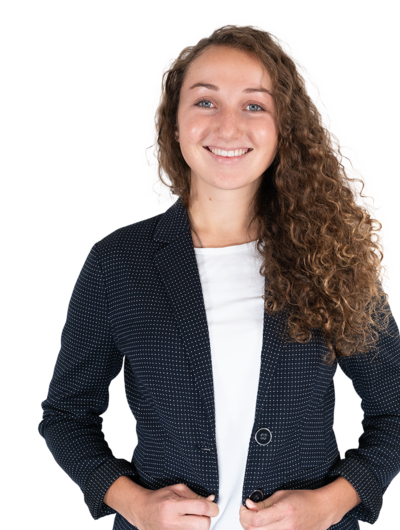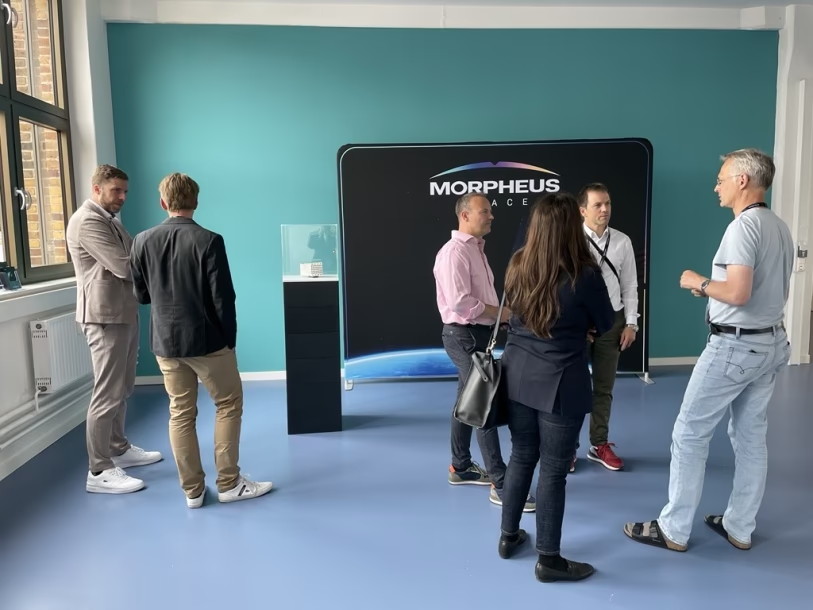
Jessica Lietze
Project Manager
Capital transfer: early-stage financing
Sachsens Wirtschaftskraft, Wachstumskapital und Erfolgsunternehmen im Fokus – beim Sächsischen Investorentag 2025 erhielten rund 70 Kapitalgebende aus ganz Deutschland einen Einblick in das Sächsische Innovationsökosystem.
Veröffentlicht am 11.06.2025
A tense calm still hangs over Albrechtsberg Castle. There is nothing to suggest that in a few hours' time, investors from all over Germany will gather here to enjoy good food and be convinced of Saxony's innovative strength. This is the fourth time that the Elbe Castle has provided an appropriate setting for the Saxon Investors' Day, which aims to offer an exclusive insight into the Saxon innovation ecosystem and its growth companies.
Even before the official start of the event, there will be initial opportunities for networking. The invited investors will have the opportunity to get to know selected scale-ups and growth companies looking for capital in private meetings. This is an important step for investments where trust plays a major role. The historically interested guests at the Investor Day will not miss out either. On a half-hour guided tour of Albrechtsberg Palace, they will learn more about the eventful history of the building.
At the start of the program, the Kronensaal is finally full and all the chairs are occupied. A good sign - there is obviously a great deal of interest in Saxony as a business location. And this is precisely the topic of the first panel of the evening, which features top-class speakers. Alongside Saxony's Minister President Michael Kretschmer, Prof. Dr. Marcel Fratzscher, President of the German Institute for Economic Research (DIW) and Ulrike Hinrichs, Spokesperson and Managing Director of the German Private Equity and Venture Capital Association, will take their seats on the stage.
Die Sachsen als Tüftler und Denker – so beschreibt sie Susanne Stump, Geschäftsführerin von futureSAX. Viele Erfindungen stammen aus dem Freistaat, wie Teebeutel, Spiegelreflexkameras oder die Zahnpasta, die heute noch unseren Alltag prägt. Ministerpräsident Kretschmer bestätigt, dass sich dieser Forschergeist bis heute bewahrt hat: „Wir haben in Sachsen sechs Spitzencluster bei der Exzellenzinitiative, das ist in Hinblick auf die Bevölkerung der höchste Anteil in ganz Deutschland. Das ist die Grundlage dafür, dass sich Unternehmen ausgründen oder herkommen.“
Marcel Fratzscher is impressed by Saxony's development since reunification: "At the beginning, Saxony was just West Germany's extended workbench. That has changed fundamentally. Saxony is now itself a driver of innovation in areas such as microelectronics and life sciences."
The stable SME sector, which invests money in research and development, also contributes to economic success. But nothing works without bright minds, Marcel Fratzscher emphasizes the Saxon school system, which is one of the best in Germany.
But all these positive developments cannot be taken for granted. Especially in difficult economic times, Ulrike Hinrichs believes that politicians have a duty: "The main task of politicians and of us is to support the positive mood. There is enough potential that we can build on. Here in Saxony anyway."
After the starter, the second panel will be more specific - it will focus on the interplay between growth capital and impact-oriented business models that strengthen Saxony's innovation ecosystem. Jens Junker, CEO of ROTOP Pharmaka from Dresden, and Christian Römlein, CEO of intelligent fluids from Dresden, are two examples of best practice from Saxony. They will be talking to Dr. Lisa Morkötter, Partner at Marondo Capital from Munich and Saxony's Minister of Economic Affairs Dirk Panter. He has a clear plan for companies with impact: "Together with many others, we want to turn these innovative companies into genuine SMEs. Together, we are all trying to facilitate a good ecosystem so that start-ups can become scale-ups and ultimately established companies."
Marcel Fratzscher is impressed by Saxony's development since reunification: "At the beginning, Saxony was just West Germany's extended workbench. That has changed fundamentally. Saxony is now itself a driver of innovation in areas such as microelectronics and life sciences."
The stable SME sector, which invests money in research and development, also contributes to economic success. But nothing works without bright minds, Marcel Fratzscher emphasizes the Saxon school system, which is one of the best in Germany.
But all these positive developments cannot be taken for granted. Especially in difficult economic times, Ulrike Hinrichs believes that politicians have a duty: "The main task of politicians and of us is to support the positive mood. There is enough potential that we can build on. Here in Saxony anyway."
After the starter, the second panel will be more specific - it will focus on the interplay between growth capital and impact-oriented business models that strengthen Saxony's innovation ecosystem. Jens Junker, CEO of ROTOP Pharmaka from Dresden, and Christian Römlein, CEO of intelligent fluids from Dresden, are two examples of best practice from Saxony. They will be talking to Dr. Lisa Morkötter, Partner at Marondo Capital from Munich and Saxony's Minister of Economic Affairs Dirk Panter. He has a clear plan for companies with impact: "Together with many others, we want to turn these innovative companies into genuine SMEs. Together, we are all trying to facilitate a good ecosystem so that start-ups can become scale-ups and ultimately established companies."
Dr. Christian Koitzsch, President of the European Semiconductor Manufacturing Company (ESMC), André Lang, Managing Director at Norafin from Mildenau and Daniel Seifert, Member of the Management Board at VR Equitypartner from Frankfurt am Main, will take part in the final panel after the main course. Moderated by Thomas Horn, Managing Director of Wirtschaftsförderung Sachsen, the panel will focus on "Successful companies in expansion & vision". André Lang will report on Norafin's expansion into the United States. The manufacturer of specialty technical nonwovens now generates over a third of its sales in the USA.
Christian Koitzsch provides insights into TSMC's search for a location for the new plant in Europe: "It became clear relatively quickly that Dresden was the right choice. Dresden is simply the capital of Europe in the semiconductor sector. It's a good ecosystem with many advantages." With Silicon Saxony, a network that unites semiconductor companies and suppliers, the TU Dresden with excellent professorships in microelectronics and research institutes such as the Fraunhofer Institute for Photonic Microsystems, there are many synergies. Christian Koitzsch is particularly pleased about the support from the region. Whether it's the expansion of the power grid, the streetcar connection or the expansion of the Dresden Vocational Training Center to train skilled workers, everyone is pulling in the same direction.
Dr. Christian Koitzsch, President of the European Semiconductor Manufacturing Company (ESMC), André Lang, Managing Director at Norafin from Mildenau and Daniel Seifert, Member of the Management Board at VR Equitypartner from Frankfurt am Main, will take part in the final panel after the main course. Moderated by Thomas Horn, Managing Director of Wirtschaftsförderung Sachsen, the panel will focus on "Successful companies in expansion & vision". André Lang will report on Norafin's expansion into the United States. The manufacturer of specialty technical nonwovens now generates over a third of its sales in the USA.
Christian Koitzsch provides insights into TSMC's search for a location for the new plant in Europe: "It became clear relatively quickly that Dresden was the right choice. Dresden is simply the capital of Europe in the semiconductor sector. It's a good ecosystem with many advantages." With Silicon Saxony, a network that unites semiconductor companies and suppliers, the TU Dresden with excellent professorships in microelectronics and research institutes such as the Fraunhofer Institute for Photonic Microsystems, there are many synergies. Christian Koitzsch is particularly pleased about the support from the region. Whether it's the expansion of the power grid, the streetcar connection or the expansion of the Dresden Vocational Training Center to train skilled workers, everyone is pulling in the same direction.
"We thrive on movement and growth, we don't want to stand still. That's why Saxony is a very interesting federal state for us. We see a strong innovative force here, for example in microelectronics or in the IT sector."
Daniel Seifert, Member of the Management Board at VR Equitypartner

Mit diesen Impulsen gibt es genug Stoff für angeregte Diskussionen im Anschluss an das Bühnenprogramm. Auf der Terrasse von Schloss Albrechtsberg lassen die Gäste den Abend in entspannter Atmosphäre ausklingen. Hier gibt es genug Raum für Vernetzung und Austausch. Doch damit nicht genug – am nächsten Vormittag öffnen zwei spannende sächsische Wachstumsunternehmen ihre Pforten für eine exklusive Werksführung. Bei Wandelbots und Morpheus Space können die Investor/-innen Innovation hautnah erleben. Ein Betriebssystem für Roboter und Antriebe für Satelliten zeigen auf, wie vielfältig das Sächsische Innovationsökosystem ist. Mit diesem gelungenen Abschluss endet der Sächsische Investorentag 2025, der einem Publikum aus ganz Deutschland erneut die Innovationskraft im Freistaat verdeutlichte.